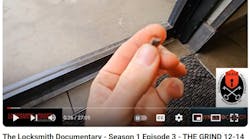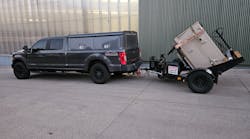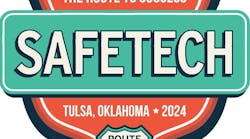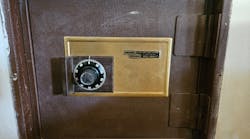Sept. 20--When the U.S. government wanted to move a nuclear warhead, it turned to Vista, Calif.-based Brown Safe Manufacturing Inc. to build the container.
When complete, the container will have to resist an attack from .50-caliber, armor-piercing bullets.
The 35-year-old company produces safes for everything from luxury watches to documents in U.S. embassies.
Founder Frederick Brown built his company in North County, raising his three children into the business, and teaching them safe manufacturing -- and safecracking. The firm got its start making safes for the military and embassies, but it was Brown's daughter, Lynel Brown-Berryhill, the company's vice president, who moved the firm into selling safes for the luxury home market.
Now they're expanding production and product lines as they move from San Marcos to new space in Vista.
"We've integrated two sectors," said Brown-Berryhill. "We make high-end, luxury safes for homes. We use the technology from the military safes we make."
They credit their survival to keeping a focus on quality, as compared with the inexpensive imports from China available on the shelves of Home Depot or Walmart.
"As a demonstration, I cracked a Home Depot safe in a minute and a half," Brown-Berryhill said. "And that was because I was worried about my dress and heels."
Brown-Berryhill says she and her brother were "raised under the desk" of their father's business.
Frederick Brown was an engineer who served in the Army, according to Shawn Berryhill, Brown-Berryhill's husband and the vice president for research at Brown Safe.
When Brown got out, he decided the safes he saw on the market were inadequate, and he went into the business. Brown's military background helped him design safes well-suited to meet the government's needs.
"We grew up, my brothers and I, under the desk basically, learning the ways of safe-cracking and all things lock," Brown-Berryhill said. "Growing up, to get our Christmas stocking, we had to crack a safe. It was always inside of one." (She plans to "initiate" her 6-year-old son to the practice this Christmas.)
In the 1980s, the safe market was flooded with inexpensive safes from China and southeast Asia.
"In reality, they're drywall wrapped in sheet metal. They're very light for shipping," Berryhill said. "From a buyer standpoint, they looked identical and cost a lot less. A lot of companies went under. All they (the cheap safes) did was organize everything for thieves."
The cheap imports forced American safe manufacturers to shift away from making safes and into importing them. Brown Safe was among the last surviving manufacturers.
But the Internet changed everything for Brown Safe, according to both Brown-Berryhill and Berryhill.
In part, they took advantage of the medium's long reach to advertise and sell their products. But it also helped generate demand.
In the pre-information superhighway days, safecracking was an art that required years to learn. But the advent of the Internet also delivered instructional websites and videos that could show anyone how to break a safe. Suddenly even the newest street thief knew that certain brands of safes could be opened up easily with a crowbar.
That's when Brown-Berryhill had the idea of selling their super-tough safes to rich people worried about their expensive watches and jewelry.
The move turned the company around and opened the door to their expansion. Now residential safes make up 60 percent of their market.
The basic Brown safe has half-inch steel walls. When a thief tries to break the safe by attacking the hinges or the lock, the safe will automatically bar itself internally with a re-locker. Even if the hinges are completely removed, the relocker keeps the safe closed. At that point, it can be opened only with heavy drills -- and most thieves don't have the time or equipment to persist at that point.
The company also took lessons from the San Diego County wildfires of 2003 and 2007, as looters often follow in the wake of a fire. Brown Safe designed its touch-pad locks with a low melting point, so that if they get too hot, the re-locker kicks in.
Brown Safe makes about 5,000 safes a year, with walls ranging in thickness from half-inch steel to 4 inches. Residential safes run from $3,000 to $16,000.
In their new space, they're planning to increase their staff from 40 to 75, and increase production to 8,000 safes a year to meet demand. Brown-Berryhill said they are flying out of the showroom.
"In the recession, people don't trust the banks, so they keep more at home," she said.
As the company's profile grew, it added private consulting to its list of services. Brown and Brown-Berryhill had long been consulting on Hollywood movies. Among others, they gave advice for the most recent "Spider-Man" movies, and for all three "Ocean's" movies.
"They always Hollywood-ize it," Brown-Berryhill said.
The new Vista space will also allow the company to open a research lab to show off its innovations, a division headed by Berryhill.
As part of their work developing safes, the company also ends up designing specialized accessories that fit into the safes. As an example, they sell gun safes to SWAT teams and riot police. In some cases, they'll design specialized firearms and helmets that can fit into the safes.
The lab staff will be key players in designing the nuclear warhead containers. Nuclear warheads are transported overland on specialized trucks, and Brown Safe will be a subcontractor to another company. The company's military-grade containers can already resist a .50-caliber bullet, but the government wants the new containers to fend off even armor-piercing bullets of that size. The company will take advantage of its access to top-secret materials and other technologies for the project.
But no matter how many custom projects they take on, all their business grows from making safes.
"We have a family commitment to quality," Brown-Berryhill said. "Safes are an heirloom. Somebody's grandchild is going to be inheriting this."
Call staff writer Eric Wolff at 760-303-1927, follow him on Twitter at ericwolff, or find energy stories on Facebook at https://www.facebook.com/Powerswitch.NCT.CAL.
Copyright 2012 - North County Times, Escondido, Calif.





